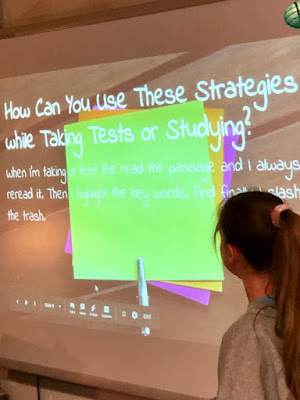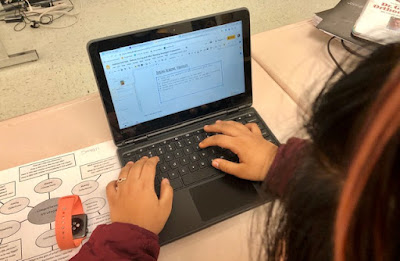We had the opportunity to teach the 6th graders in Mrs. Hannah's class about before, during and after reading strategies, along with examples from what we've learned and applied this year. The 7th graders also gave the 6th graders tips on test-taking and how they can use all of these strategies in other content areas, such as history and science.
Enjoy the photos of our current (and future) teachers!
Someplace To Go Without Moving
"Reading Gives Us Someplace To Go When We Have To Stay Where We Are!" - Mason Cooley
Thursday, April 11, 2019
Friday, April 5, 2019
THE STUDENTS ARE NOW THE TEACHERS!
CHECK OUT the EXCELLENT video created by one of our talented Accelerated Literacy Skills students...
In our previous post, I detailed the Google Presentations the students were creating to demonstrate their knowledge of before, during and after reading comprehension strategies, as well as providing real-world application from their studies, online portfolios, and classroom anchor charts.
Through the creation of their presentations, they are transitioning from student to teacher. They will teach other students about the power of interacting with text. We are excited to teach the 6th graders what it means to be active readers, who engage with reading.
Enjoy a sample of our students teaching!
Friday, March 1, 2019
The Students Become Teachers - Applying and Teaching What We Know!
The students are actively applying before, during, and after reading comprehension strategies, vocabulary development, and test-taking strategies learned throughout the year by consciously thinking about what they are reading. Instead of being passive readers who just read the words, they are transitioning to active readers who interact with text.
The students have learned multiple test-taking and reading comprehension strategies this year. Through active engagement, leveled-learning, differentiation based on data and informal observations, application, flexible seating, and small and large group instruction, they have participated in multiple reading comprehension activities to aid in the navigation of fiction and non-fiction text across multiple genres.
The students are creating Google Presentations to demonstrate their knowledge of strategies, as well as providing real-world application from their studies, online portfolios, and classroom anchor charts. Through the creation of their presentations, they are transitioning from student to teacher. They will teach other students about the power of interacting with text.
The students have online portfolios, where they will continuously reflect on their learning. They are also using a rubric as a guide. The students will revise their ideas and receive feedback from peer and teacher conferencing.
Wednesday, February 6, 2019
The Active Reader - Before, During & After Reading Comprehension Strategies
We are applying before, during, and after reading and test-taking strategies we learned throughout the year by consciously thinking about what we are reading. Instead of being passive readers, we are becoming active readers who interact with text.
The students generated lists of test-taking strategies in Reading Lab. The Accelerated Literacy Skills class has learned multiple reading comprehension strategies to aid them in navigating text. Now, we are blending the skills together to create a holistic, active reader, who can answer comprehension questions through interactions with text and developed innate test-taking strategies.
 |
Keep Reading ACTIVE!!!
Tuesday, January 22, 2019
Making Inferences Using Facts and Evidence
After thinking about what it means to make an inference, we started our lesson by watching a YouTube video on making inferences. The students then provided their "take-away" from the video.
After being introduced to the book, Christopher Reeve A Real-Life Super Hero, we watched a YouTube video from the perspective of Christopher Reeve's son.
The students were then shown a chart that included fact, inference, and evidence.
The lesson was modeled with a read aloud of the introduction of the book. Then, each student was provided a copy of the introduction. As a group, we highlighted facts, produced inferences, and provided evidence to support our ideas and added them to our class chart.
The students were then placed in small groups and provided a different chapter, 1-5. They completed the fact/inference/evidence form as a group by highlighting the facts, forming inferences, and producing evidence for support.
Sharing facts, inferences, and evidence from their chapters with classmates!
After being introduced to the book, Christopher Reeve A Real-Life Super Hero, we watched a YouTube video from the perspective of Christopher Reeve's son.
The students were then shown a chart that included fact, inference, and evidence.
The lesson was modeled with a read aloud of the introduction of the book. Then, each student was provided a copy of the introduction. As a group, we highlighted facts, produced inferences, and provided evidence to support our ideas and added them to our class chart.
The students were then placed in small groups and provided a different chapter, 1-5. They completed the fact/inference/evidence form as a group by highlighting the facts, forming inferences, and producing evidence for support.
Working together!!
Sharing facts, inferences, and evidence from their chapters with classmates!
Subscribe to:
Comments (Atom)








































































